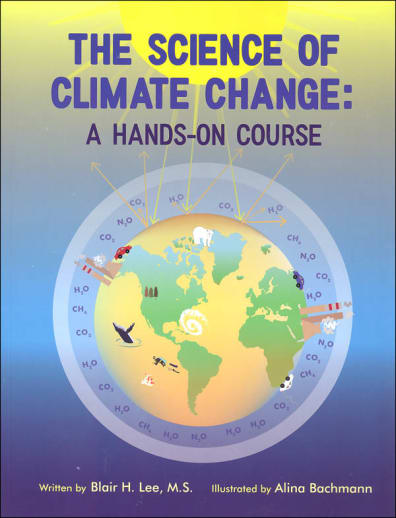Bringing together scientific theories and hands-on activities, this supplemental course teaches the science of global warming and climate change. Starting with air and the molecules that make it, the author teaches children about the greenhouse effect, global warming, the difference between climate and weather, and climate change. She concludes by looking at how we can all do our part to solve the climate crisis. The text is conversational and includes brightly colored graphics to illustrate the concepts. Labs and activities are numerous, use easy to find items, and are thoroughly explained. The book is written to be interactive with students reading through the science concepts and completing a related activity. Activities vary and include short answer questions, graphing trends or filling in illustrations and performing easy to implement lab experiments. An excellent supplement to any earth or physical science course. Divided into 4 parts with 18 activities. Back of the book includes glossary, supply list, template pages, and an answer key. Activity pages are reproducible for purchasing family only. 91 pgs, pb. ~Deanne
Science of Climate Change
Description
The Science of Climate Change: A Hands-On Courseuses text andeighteen hands-on activitiesto explain and teach the science of global warming and climate change, how humans are responsible, and what can be done to slow or stop the rate of global warming and climate change.
The course is thorough, covering fundamental topics needed to understand the science of climate change. Some of these topics you might not considered before. Topics like this one: Greenhouse gas molecules are in air at a low concentration, but does that mean that there aren't very many of them? It all depends how many gas molecules are in a volume of air. It turns out there are so many molecules in a small volume of air that even a low concentration of greenhouse gas molecules is a huge number.The Science of Climate Change: A Hands-On Courseis geared toward a range of age levels. To make sure that the materials are accessible for all students in that age range this graphing activity has two versions. One set of graphs is a dot-to-dot activity for younger learners, where much of the graphing work has been done, and the real work is answering the questions at the end of the activity. There is also a version for older learners who use the information from a data table and to plot data points on the graphs.
The activities include hands-on labs, coloring, graphing, scientific modeling, and even a field trip. This coloring activity looks at the difference between the amounts of products that can be made from materials that are not recycled materials versus recycled materials using the same amount of energy. Recycling is one of the simple steps people can take to shrink their carbon footprint.
| Product Format: | Paperback |
|---|---|
| Grades: | 4-8 |
| Brand: | Secular, Eclectic, Academic |
| Author: | Blair Lee |
| ISBN: | 9781947473003 |
| Length in Inches: | 11 |
| Width in Inches: | 8.5 |
| Height in Inches: | 0.25 |
| Weight in Pounds: | 0.7 |

